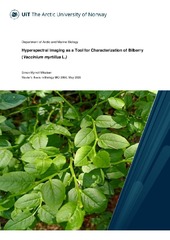Hyperspectral Imaging as a Tool for Characterization of Bilberry (Vaccinium myrtillus L.)
Forfatter
Mikalsen, Simon MyrvollSammendrag
Plants growing at high latitudes are subjected to environmental conditions with significantly different light and temperature regimes compared to lower latitudes, which can influence local adaptations related to the plant’s secondary metabolite profile. Several studies have demonstrated the potential of utilizing hyperspectral imaging in plant phenotyping. This thesis provides insight into how plant leaf spectral features are influenced by desiccation, and how these changes may reflect group-specific signatures related to underlying shifts in the composition of secondary metabolites. In this thesis, hyperspectral imaging using visible and near-infrared (VNIR) and short-wave infrared (SWIR) sensors was applied to fresh and dry leaves of two different species – Vaccinium Myrtillus L. and Cornus Suecica L. – and two ecotypes of V. myrtillus growing in different locations –Norway (69°N) and Germany (50°N) – imaged in a dry state. In addition, chemical analysis (LC-qTOF-MS) of plant metabolites was applied to the two distinct ecotypes to investigate the relationship between the spectral (400-1700 nm) and chemical features of the leaves using predictive models. Principal component analysis (PCA) on reflectance and chemical data showed separation between fresh and dry leaves in both species, in addition ecotypes when using spectral data only. Interestingly, desiccation can increase within-group variability of dry leaves, possibly due to unmasking of other latent features caused by the removal of water. Desiccation had notable effects on the separability of the species and ecotypes, although in different spectral regions. Multiple classes of compounds differed in abundance among the two ecotypes, two of which – among flavonoids and sesquiterpenoids – were chosen as targets for Partial Least Squares Regression (PLSR2) analysis. PLSR models had poor to moderate performance in predicting the abundance of the class compounds in both regions (Global Q2 = 0.69 and 0.73, Global R2 = 0.71 and 0.75, for VNIR and SWIR respectively). The target class compounds exhibit a strong positive correlation with other class compounds, and the prediction performance of the PLSR models may therefore be based on the presence of other more spectrally dominant compounds. The results from this study demonstrate the viability of using dry leaf reflectance to distinguish between species and ecotypes, as well as to predict the abundance of specific class compounds.
Forlag
UiT The Arctic University of NorwayMetadata
Vis full innførselSamlinger
Copyright 2025 The Author(s)


 English
English norsk
norsk
